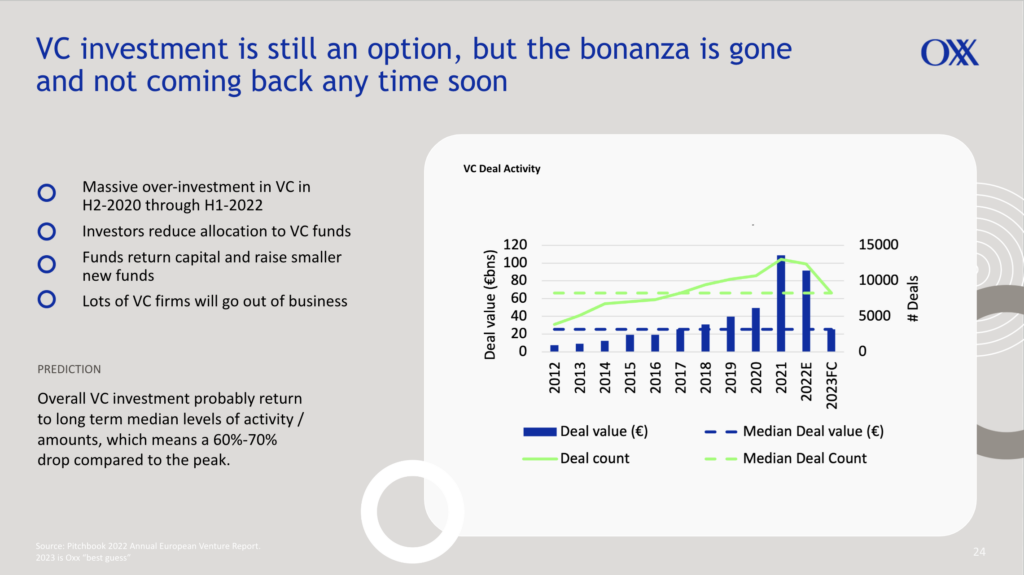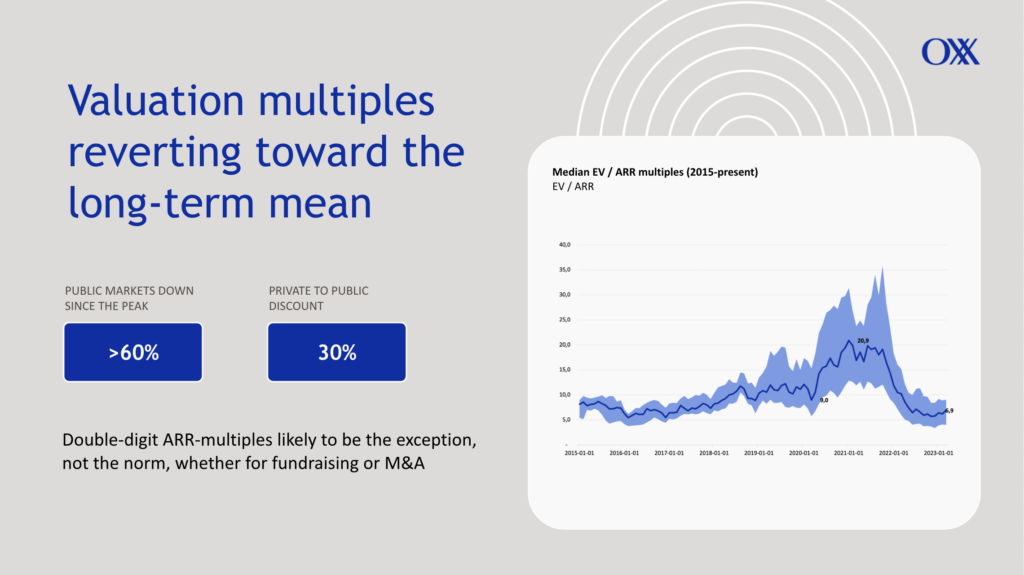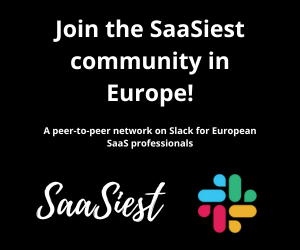Oxx’s co-founder and general partner (and self-proclaimed SaaS geek), Mikael Johnsson, took the stage for a second year, delivering an insightful, stat-backed talk about the state of SaaS in 2023, including a review of the wildly turbulent SaaS landscape over the past few years and a look ahead to where the market is trending.

Takeaways
- 2020-2021 saw unprecedented investments in SaaS companies at record valuations – up by a factor of five. However, the market changed dramatically in 2022 due to rising inflation, increasing interest rates, geopolitical uncertainty, and the slowdown in economic growth.
- SaaS is still growing, but at a slower pace. Companies need to be more realistic about their expectations and adjust to the new reality of a more conservative market.
- Investors have a lower appetite for risk and are now more focused on capital efficiency and profitability than the growth-at-all-costs mindset.
- VC money is still an option, but will be scarcer and more expensive as valuations are expected to return to the long-term mean (60-70% less than at the peak in 2021).
- The SaaS space is still a great place to be. Long-term megatrends continue. Leaders can build great products much faster and at a much lower investment than ever before.
- There’s a major opportunity to tap into the AI innovation wave.
2020-2021 saw unprecedented investments in SaaS
2020 started out rough with the COVID pandemic spreading across the world. But in the land of SaaS, the outlook quickly turned cheery. A massive fiscal stimulus, historically low interest rates, and the transition to remote work drove investments and consumption. The public market valuation for SaaS companies went through the roof to completely unprecedented levels, and the number of SaaS IPOs broke all previous records. The private VC-driven market was up by a factor of five, driving dramatic increases in valuations with the average series A round being raised at 63% higher value compared to the long-term median. The highest impact came with SaaS companies at the later stages with the B and C rounds increasing in price by 300-400%.
…but the bubble couldn’t last
In 2022, inflation increased to double-digit numbers. Central banks increased interest rates by 3-4x, which spread quickly to both consumer and business lending. The stock market took a nosedive with tech stocks going into a tailspin. Economic growth slowed. Geopolitical uncertainty abounded with the war in Ukraine, and giant tech companies that had been fighting tooth and nail for talent started to lay off people instead.
SaaS companies have an uphill battle in 2023, but they’re still growing
With high inflation, the slowdown in economic growth, and increasing interest rates in 2023, the stock market has come down quite dramatically, specifically for tech stocks and in SaaS. The index Oxx tracks is down about 60% year-over-year. Pessimism is spreading to private markets. Venture investment was down 70% in the fourth quarter of 2022 as compared to the fourth quarter of 2021. Data for the first quarter of 2023 shows the trend continuing steadily downwards, both in terms of amounts and the number of deals. The exit market dried up the second half of 2022, which saw the lowest exit activity since 2016. IPO markets are down. Risk appetite is at a low. The large strategic companies that usually acquire companies are focused on cost-cutting rather than adding growth through acquisition. And the very large private equity firms have largely been sitting on the sidelines waiting for valuations to come down and interest rates to stabilize before they start to push on the gas.
On a more positive note, software spend is still increasing. According to Morgan Stanley’s annual CIO survey, spend for software products in the enterprise will grow 3% this year. And the move towards cloud and SaaS continues on a steady slope. There’s a lot of legacy software that’s going to be replaced, providing opportunity for SaaS leaders who are building great new products. The top near-term priority areas are cloud infrastructure, data, and cybersecurity.
The average software company is growing, but at a slower pace compared to a year ago. Churn is increasing, and sales cycles are extending. Customers are pushing to de-bundle software packages and buy just one piece of the software, and they’re trying to consolidate the number of vendors to increase their buying power. There’s aggressive discounting. Buyers are pushing for variable pricing where they’re only paying for what they’re using or the value they’re receiving. And there’s a lot more talk about payment terms.
There’s been a strong shift in investors’ appetite from growth at all costs towards capital efficient growth. SaaS companies with a positive EBITDA margin have dropped on average by a value of 47% year-over-year. Companies with a negative EBITDA margin have seen their value decrease by a factor of 69%. So there’s a 50% difference in favor of those companies that are profitable.
So, what’s next?
Longer-term mega trends that drive growth continue
It’s not all bad news. Important growth drivers for SaaS companies remain in 2023, providing opportunity amidst the chaos.
- Digitalization is a top priority for any organization. Every business process that can be automated and run on software will be as such.
- The continued move to cloud is expected to double its penetration in the enterprise in the next couple of years.
- Data is still growing exponentially. Businesses need to harness that data to make better, smarter, faster, and more timely decisions.
- Entrepreneurs can build great products much faster and at a much lower investment thanks to cloud infrastructure, open source tools, no-code and low-code tools, and repositories.
- The availability of the large language models and generative AI is driving a lot of innovation and opportunity at the infrastructure, tooling, and application layers.
Mindset is shifting from growth at all costs to profitability at all costs
Market dynamics have brought a massive switch from growth at all costs to profitability at all costs. But that doesn’t mean that SaaS leaders are off the hook for growth. It’s possible to build a successful, capital-efficient software company with limited external investment and an eye toward profitability.
“Capital efficiency might be king, but growth is still queen.”
Making a trade sale exit to a strategic buyer versus shooting for the moon and building a really large company with significant amounts of external capital and driving it to IPO are equally viable. There’s room in the market for both, and we need to stop saying that it’s either/or.

VC money will be scarcer and more expensive
VC investment to accelerate your growth is still an option, but that money is going to be scarcer and more expensive. Why? VCs have been burned by overinvestment in the last couple of years, and investors in the VC funds are now finding better returns in less risky asset classes.
VC investment will return to the long-term median, which represents a decrease of 60-70% compared to the peak of the market. With that reduction in capital will come a normalization of valuations. Public market multiples have come down for SaaS companies by about 60%, and eventually those are what will determine the valuation multiples in the private market in the long term. Historically, there has been a discount in private market multiples compared to the public market multiples of about 30%. The days of double-digit ARR multiples will be more of an exception rather than a norm, with the exception of pre-revenue seed and very early series A companies.
The M&A market has been completely frozen, but we’ll see a dramatic shift in this over the next 12 months for a few reasons. The largest private equity buyers are sitting on hundreds of billions of dry powder that they’ve raised to go on an acquisition spree. Additionally, many companies funded during the heyday of 2020-2021 will not be able to raise follow-on funding or turn into profitable businesses in the near term, opening up consolidation opportunities.
AI pave the way for innovation and higher expectations
With large language models and generative AI coming very quickly into the mainstream, the genie is out of the bottle. Customers will expect software to function as easily as an application like ChatGPT where you can tell the software in plain language what you want rather than spending weeks or months trying to understand and learn how to operate a piece of software.
There will also be an incredible amount of innovation in two major ways: building on top of these large language models and building plugins to these AI models to enable all of your software.
“If you don’t have a strategy for how to think about AI and ML, it’s time to get one right now.”
What does this all mean?
Though the market has changed in terms of investments and valuations, it’s still a great time for building a SaaS company. The mega trends still support that, AI opens up a world of possibilities in terms of innovation, and the market is rife with solid talent. The greatest shift in mindset will be about building long-term valuable and sustainable businesses, whereby SaaS leaders measure the success based on how they build that company rather than how much funding they’re raising and at what valuations.




